Fluoroquinolones Suppress TGF-β and PMA-Induced MMP-9 Production in Cancer Cells: Implications in Repurposing Quinolone Antibiotics for Cancer Treatment
Abstract
:1. Introduction
2. Results
2.1. FQs Inhibited Cancer Cell Migration and Invasion
2.2. FQs Reduced TGF-β-Induced MMP-9 Expression and Secretion
2.3. FQs Inhibited Activation of TGF-β-Dependent p38, but Not Smad2/3
3. Discussion
4. Materials and Methods
4.1. Cell Culture
4.2. Reagents and Antibodies
4.3. Cell Viability and Toxicity Assays
4.4. Preparation of CM
4.5. Western Blot Analysis
4.6. Gelatin Zymography
4.7. Wound Healing Assay
4.8. Cell Invasion Assay
4.9. Determination of Intracellular cAMP Level
4.10. Luciferase Assay
4.11. RT-PCR
4.12. Statistical Analysis
Supplementary Materials
Author Contributions
Funding
Institutional Review Board Statement
Data Availability Statement
Acknowledgments
Conflicts of Interest
References
- Hanahan, D.; Weinberg, R.A. The Hallmarks of Cancer. Cell 2000, 100, 57–70. [Google Scholar] [CrossRef] [Green Version]
- Gandalovivá, A.; Rosel, D.; Fernandes, M.; Veselý, P.; Heneberg, P.; Čermák, V.; Petruželka, L.; Kumar, S.; Sanz-Moreno, V.; Brábek, J. Migrastatics-Anti-metastatic and Anti-invasion Drugs: Promises and Challenges. Trends Cancer 2017, 3, 391–406. [Google Scholar] [CrossRef] [PubMed] [Green Version]
- Conlon, G.A.; Murray, G.I. Recent advances in understanding the roles of matrix metalloproteinases in tumour invasion and metastasis. J. Pathol. 2018, 247, 629–640. [Google Scholar] [CrossRef] [Green Version]
- Scheau, C.; Badarau, I.A.; Costache, R.; Caruntu, C.; Mihai, G.L.; Didilescu, A.C.; Constantin, C.; Neagu, M. The Role of Matrix Metalloproteinases in the Epithelial-Mesenchymal Transition of Hepatocellular Carcinoma. Anal. Cell. Pathol. 2019, 2019, 1–10. [Google Scholar] [CrossRef] [Green Version]
- Jin, M.L.; Park, S.Y.; Kim, Y.H.; Park, G.; Lee, S.J. Halofuginone induces the apoptosis of breast cancer cells and inhibits migration via downregulation of matrix metalloproteinase-9. Int. J. Oncol. 2013, 44, 309–318. [Google Scholar] [CrossRef] [PubMed]
- Lyons, J.; Birkedal-Hansen, B.; Pierson, M.; Whitelock, J. Interleukin-1 beta and transforming growth factor-alpha/epidermal growth factor induce expression of M(r) 95,000 type IV collagenase/gelatinase and interstitial fibroblast-type collagenase by rat mucosal keratinocytes. J. Biol. Chem. 1993, 268, 19143–19151. [Google Scholar] [CrossRef]
- Kamiya, T.; Tanaka, M.; Hara, H.; Yamaguchi, E.; Itoh, A.; Adachi, T. Inhibitory effects of 4-hydroperoxy-2-decenoic acid ethyl ester on phorbol ester- and TGF-β1-induced MMPs expression. Free Radic. Res. 2019, 53, 1051–1059. [Google Scholar] [CrossRef] [PubMed]
- Gialeli, C.; Theocharis, A.D.; Karamanos, N.K. Roles of matrix metalloproteinases in cancer progression and their pharmacological targeting. FEBS J. 2010, 278, 16–27. [Google Scholar] [CrossRef] [PubMed]
- Safina, A.; Ren, M.-Q.; Vandette, E.; Bakin, A. TAK1 is required for TGF-β1-mediated regulation of matrix metalloproteinase-9 and metastasis. Oncogene 2007, 27, 1198–1207. [Google Scholar] [CrossRef] [PubMed] [Green Version]
- Vandenbroucke, R.; Libert, C. Is there new hope for therapeutic matrix metalloproteinase inhibition? Nat. Rev. Drug Discov. 2014, 13, 904–927. [Google Scholar] [CrossRef]
- Coussens, L.M.; Fingleton, B.; Matrisian, L.M. Matrix Metalloproteinase Inhibitors and Cancer—Trials and Tribulations. Science 2002, 295, 2387–2392. [Google Scholar] [CrossRef]
- Radisky, E.S.; Raeeszadeh-Sarmazdeh, M.; Radisky, D.C. Therapeutic Potential of Matrix Metalloproteinase Inhibition in Breast Cancer. J. Cell. Biochem. 2017, 118, 3531–3548. [Google Scholar] [CrossRef] [PubMed] [Green Version]
- Cathcart, J.; Pulkoski-Gross, A.; Cao, J. Targeting matrix metalloproteinases in cancer: Bringing new life to old ideas. Genes Dis. 2015, 2, 26–34. [Google Scholar] [CrossRef] [PubMed] [Green Version]
- Idowu, T.; Schweizer, F. Ubiquitous Nature of Fluoroquinolones: The Oscillation between Antibacterial and Anticancer Activities. Antibiotics 2017, 6, 26. [Google Scholar] [CrossRef] [PubMed] [Green Version]
- Gong, J.H.; Liu, X.J.; Shang, B.Y.; Chen, S.Z.; Zhen, Y.S. HERG K+ channel related chemosensitivity to sparfloxacin in colon cancer cells. Oncol. Rep. 2010, 23, 1747–1756. [Google Scholar] [CrossRef]
- Yadav, V.; Sultana, S.; Yadav, J.; Saini, N. Gatifloxacin Induces S and G2-Phase Cell Cycle Arrest in Pancreatic Cancer Cells via p21/p27/p53. PLoS ONE 2012, 7, e47796. [Google Scholar] [CrossRef] [PubMed]
- Kloskowski, T.; Gurtowska, N.; Nowak, M.; Joachimiak, R.; Bajek, A.; Olkowska, J.; Drewa, T. The influence of ciprofloxacin on viability of A549, HepG2, A375.S2, B16 and C6 cell lines in vitro. Acta Pol. Pharm.—Drug Res. 2011, 68, 859–865. [Google Scholar]
- Azéma, J.; Guidetti, B.; Dewelle, J.; Le Calve, B.; Mijatovic, T.; Korolyov, A.; Vaysse, J.; Malet-Martino, M.; Martino, R.; Kiss, R. 7-((4-Substituted)piperazin-1-yl) derivatives of ciprofloxacin: Synthesis and in vitro biological evaluation as potential antitumor agents. Bioorganic Med. Chem. 2009, 17, 5396–5407. [Google Scholar] [CrossRef]
- Dalhoff, A. Immunomodulatory Activities of Fluoroquinolones. Infection 2005, 33, 55–70. [Google Scholar] [CrossRef]
- Dalhoff, A.; Shalit, I. Immunomodulatory effects of quinolones. Lancet Infect. Dis. 2003, 3, 359–371. [Google Scholar] [CrossRef]
- Raker, V.K.; Becker, C.; Esteinbrink, K. The cAMP Pathway as Therapeutic Target in Autoimmune and Inflammatory Diseases. Front. Immunol. 2016, 7, 123. [Google Scholar] [CrossRef] [Green Version]
- Wang, J.-P.; Raung, S.-L.; Huang, L.-J.; Kuo, S.-C. Involvement of cyclic AMP generation in the inhibition of respiratory burst by 2-phenyl-4-quinolone (YT-1) in rat neutrophils. Biochem. Pharmacol. 1998, 56, 1505–1514. [Google Scholar] [CrossRef]
- Santibáñez, J.F.; Olivares, D.; Guerrero, J.; Martínez, J. Cyclic AMP inhibits TGFβ1-induced cell-scattering and invasiveness in murine-transformed keratinocytes. Int. J. Cancer 2003, 107, 715–720. [Google Scholar] [CrossRef] [PubMed]
- Lee, S.Y.; Kim, H.J.; Lee, W.J.; Joo, S.H.; Jeon, S.-J.; Kim, J.W.; Han, S.-H.; Lee, J.; Park, S.H.; Cheong, J.H.; et al. Differential Regulation of Matrix Metalloproteinase-9 and Tissue Plasminogen Activator Activity by the Cyclic-AMP System in Lipopolysaccharide-stimulated Rat Primary Astrocytes. Neurochem. Res. 2008, 33, 2324–2334. [Google Scholar] [CrossRef] [PubMed]
- Zhang, J.; Bui, T.N.; Xiang, J.; Lin, A. Cyclic AMP Inhibits p38 Activation via CREB-Induced Dynein Light Chain. Mol. Cell. Biol. 2006, 26, 1223–1234. [Google Scholar] [CrossRef] [PubMed] [Green Version]
- Cao, W.; Daniel, K.W.; Robidoux, J.; Puigserver, P.; Medvedev, A.; Bai, X.; Floering, L.M.; Spiegelman, B.M.; Collins, S. p38 Mitogen-Activated Protein Kinase Is the Central Regulator of Cyclic AMP-Dependent Transcription of the Brown Fat Uncoupling Protein 1 Gene. Mol. Cell. Biol. 2004, 24, 3057–3067. [Google Scholar] [CrossRef] [PubMed] [Green Version]
- Hansen, T.V.O.; Rehfeld, J.F.; Nielsen, F.C. Cyclic AMP-Induced Neuronal Differentiation via Activation of p38 Mitogen-Activated Protein Kinase. J. Neurochem. 2002, 75, 1870–1877. [Google Scholar] [CrossRef]
- Ho, A.K.; Price, L.; Mackova, M.; Chik, C.L. Potentiation of cyclic AMP and cyclic GMP accumulation by p38 mitogen-activated protein kinase (p38MAPK) inhibitors in rat pinealocytes. Biochem. Pharmacol. 2001, 62, 1605–1611. [Google Scholar] [CrossRef]
- Ma, H.; Liu, Z.; Zhong, C.-Q.; Liu, Y.; Zhang, Z.; Liang, Y.; Li, J.; Han, S.; Han, J. Inactivation of Cyclic AMP Response Element Transcription Caused by Constitutive p38 Activation Is Mediated by Hyperphosphorylation-Dependent CRTC2 Nucleocytoplasmic Transport. Mol. Cell. Biol. 2019, 39, e00554-18. [Google Scholar] [CrossRef] [Green Version]
- Massagué, J. TGFβ signalling in context. Nat. Rev. Mol. Cell Biol. 2012, 13, 616–630. [Google Scholar] [CrossRef]
- Easom, R.A.; Hughes, J.H.; Landt, M.; Wolf, B.A.; Turk, J.; McDaniel, M.L. Comparison of effects of phorbol esters and glucose on protein kinase C activation and insulin secretion in pancreatic islets. Biochem. J. 1989, 264, 27–33. [Google Scholar] [CrossRef] [Green Version]
- Genersch, E.; Hayess, K.; Neuenfeld, Y.; Haller, H. Sustained ERK phosphorylation is necessary but not sufficient for MMP-9 regulation in endothelial cells: Involvement of Ras-dependent and -independent pathways. J. Cell Sci. 2000, 113, 4319–4330. [Google Scholar] [CrossRef] [PubMed]
- Park, M.J.; Park, I.C.; Lee, H.C.; Woo, S.H.; Lee, J.Y.; Hong, Y.J.; Rhee, C.H.; Lee, Y.S.; Lee, S.H.; Shim, B.S.; et al. Protein kinase C-alpha activation by phorbol ester induces secretion of gelatinase B/MMP-9 through ERK 1/2 pathway in capillary endo-thelial cells. Int. J. Oncol. 2003, 22, 137–143. [Google Scholar] [PubMed]
- Simon, C.; Goepfert, H.; Boyd, D. Inhibition of the p38 mitogen-activated protein kinase by SB 203580 blocks PMA-induced Mr 92,000 type IV collagenase secretion and in vitro invasion. Cancer Res. 1998, 58, 1135–1139. [Google Scholar]
- Takahashi, Y.; Maki, T.; Liang, A.C.; Itoh, K.; Lok, J.; Osumi, N.; Arai, K. p38 MAP kinase mediates transforming-growth factor-β1-induced upregulation of matrix metalloproteinase-9 but not -2 in human brain pericytes. Brain Res. 2014, 1593, 1–8. [Google Scholar] [CrossRef] [PubMed] [Green Version]
- Zhao, P.; Li, X.-G.; Yang, M.; Shao, Q.; Wang, D.; Liu, S.; Song, H.; Song, B.; Zhang, Y.; Qu, X. Hypoxia suppresses the production of MMP-9 by human monocyte-derived dendritic cells and requires activation of adenosine receptor A2b via cAMP/PKA signaling pathway. Mol. Immunol. 2008, 45, 2187–2195. [Google Scholar] [CrossRef] [PubMed]
- Egeblad, M.; Werb, Z. New functions for the matrix metalloproteinases in cancer progression. Nat. Rev. Cancer 2002, 2, 161–174. [Google Scholar] [CrossRef]
- Ylisirnio, S.; Hoyhtya, M.; Turpeenniemi-Hujanen, T. Serum matrix metalloproteinases -2, -9 and tissue inhibitors of metal-loproteinases -1, -2 in lung cancer--TIMP-1 as a prognostic marker. Anticancer Res. 2000, 20, 1311–1316. [Google Scholar]
- Choe, G.; Park, J.K.; Jouben-Steele, L.; Kremen, T.J.; Liau, L.; Vinters, H.V.; Cloughesy, T.F.; Mischel, P.S. Active matrix metalloproteinase 9 expression is associated with primary glioblastoma subtype. Clin. Cancer Res. 2002, 8, 2894–2901. [Google Scholar] [PubMed]
- Yang, X.; Staren, E.D.; Howard, J.M.; Iwamura, T.; Bartsch, J.E.; Appert, H.E. Invasiveness and MMP Expression in Pancreatic Carcinoma. J. Surg. Res. 2001, 98, 33–39. [Google Scholar] [CrossRef]
- Suzuki, T.; Kuwabara, Y.; Iwata, H.; Mitani, M.; Shinoda, N.; Sato, A.; Mitsui, A.; Sugiura, M.; Kato, J.; Fujii, Y. Role of matrix metalloproteinase-9 in in vitro invasion of esophageal carcinoma cells. J. Surg. Oncol. 2002, 81, 80–86. [Google Scholar] [CrossRef] [PubMed]
- Ishimaru, H.; Kageyama, Y.; Hayashi, T.; Nemoto, T.; Eishi, Y.; Kihara, K. Expression of matrix metalloproteinase-9 and bombesin/gastrin-releasing peptide in human prostate cancers and their lymph node metastases. Acta Oncol. 2002, 41, 289–296. [Google Scholar] [CrossRef] [PubMed]
- Albo, D.; Shinohara, T.; Tuszynski, G.P. Up-regulation of Matrix Metalloproteinase 9 by Thrombospondin 1 in Gastric Cancer. J. Surg. Res. 2002, 108, 51–60. [Google Scholar] [CrossRef]
- Kalembeyi, I.; Inada, H.; Nishiura, R.; Imanaka-Yoshida, K.; Sakakura, T.; Yoshida, T. Tenascin-C upregulates matrix metalloproteinase-9 in breast cancer cells: Direct and synergistic effects with transforming growth factor β1. Int. J. Cancer 2003, 105, 53–60. [Google Scholar] [CrossRef] [PubMed]
- Morelli, C.; Campioni, K.; Parolin, C.; Palù, G.; Tognon, M. Activity of the matrix metalloproteinase-9 promoter in human normal and tumor cells. J. Cell. Physiol. 2003, 199, 126–133. [Google Scholar] [CrossRef]
- Kim, E.-S.; Kim, M.-S.; Moon, A. TGF-beta-induced upregulation of MMP-2 and MMP-9 depends on p38 MAPK, but not ERK signaling in MCF10A human breast epithelial cells. Int. J. Oncol. 2004, 25, 1375–1382. [Google Scholar] [PubMed]
- Dziembowska, M.; Danilkiewicz, M.; Wesolowska, A.; Zupanska, A.; Chouaib, S.; Kaminska, B. Cross-talk between Smad and p38 MAPK signalling in transforming growth factor β signal transduction in human glioblastoma cells. Biochem. Biophys. Res. Commun. 2007, 354, 1101–1106. [Google Scholar] [CrossRef]
- Denner, D.R.; Udan-Johns, M.L.; Nichols, M.R. Inhibition of matrix metalloproteinase-9 secretion by dimethyl sulfoxide and cyclic adenosine monophosphate in human monocytes. World J. Biol. Chem. 2021, 12, 1–14. [Google Scholar] [CrossRef]
- McCAWLEY, L.J.; Li, S.; Benavidez, M.; Halbleib, J.; Wattenberg, E.V.; Hudson, L.G. Elevation of Intracellular cAMP Inhibits Growth Factor-Mediated Matrix Metalloproteinase-9 Induction and Keratinocyte Migration. Mol. Pharmacol. 2000, 58, 145–151. [Google Scholar] [CrossRef] [Green Version]
- Ernens, I.; Rouy, D.; Velot, E.; Devaux, Y.; Wagner, D.R. Adenosine Inhibits Matrix Metalloproteinase-9 Secretion by Neutrophils. Circ. Res. 2006, 99, 590–597. [Google Scholar] [CrossRef] [PubMed] [Green Version]
- Derynck, R.; Zhang, Y. Smad-dependent and Smad-independent pathways in TGF-β family signalling. Nature 2003, 425, 577–584. [Google Scholar] [CrossRef]
- Clark, I.M.; Swingler, T.E.; Sampieri, C.L.; Edwards, D. The regulation of matrix metalloproteinases and their inhibitors. Int. J. Biochem. Cell Biol. 2008, 40, 1362–1378. [Google Scholar] [CrossRef] [PubMed] [Green Version]
- Hsieh, H.-L.; Wang, H.-H.; Wu, W.-B.; Chu, P.-J.; Yang, C.-M. Transforming growth factor-β1 induces matrix metalloproteinase-9 and cell migration in astrocytes: Roles of ROS-dependent ERK- and JNK-NF-κB pathways. J. Neuroinflamm. 2010, 7, 88. [Google Scholar] [CrossRef] [Green Version]
- Blaine, T.A.; Pollice, P.F.; Rosier, R.N.; Reynolds, P.R.; Puzas, J.E.; O’Keefe, R.J. Modulation of the production of cytokines in titanium-stimulated human peripheral blood monocytes by pharmacological agents. The role of cAMP-mediated signaling mechanisms. J. Bone Joint Surg. Am. 1997, 79, 1519–1528. [Google Scholar] [CrossRef]
- Zusso, M.; Lunardi, V.; Franceschini, D.; Pagetta, A.; Lo, R.; Stifani, S.; Frigo, A.C.; Giusti, P.; Moro, S. Ciprofloxacin and levofloxacin attenuate microglia inflammatory response via TLR4/NF-kB pathway. J. Neuroinflamm. 2019, 16, 1–12. [Google Scholar] [CrossRef] [Green Version]
- Gong, Y.; Hart, E.; Shchurin, A.; Hoover-Plow, J. Inflammatory macrophage migration requires MMP-9 activation by plasminogen in mice. J. Clin. Investig. 2008, 118, 3012–3024. [Google Scholar] [CrossRef] [PubMed] [Green Version]
- Fayard, B.; Bianchi, F.; Dey, J.; Moreno, E.; Djaffer, S.; Hynes, N.E.; Monard, D. The Serine Protease Inhibitor Protease Nexin-1 Controls Mammary Cancer Metastasis through LRP-1–Mediated MMP-9 Expression. Cancer Res. 2009, 69, 5690–5698. [Google Scholar] [CrossRef] [Green Version]
- Gonzalez-Avila, G.; Sommer, B.; Mendoza-Posada, D.A.; Ramos, C.; Garcia-Hernandez, A.A.; Falfán-Valencia, R. Matrix metalloproteinases participation in the metastatic process and their diagnostic and therapeutic applications in cancer. Crit. Rev. Oncol. 2019, 137, 57–83. [Google Scholar] [CrossRef]
- Jonk, L.J.C.; Itoh, S.; Heldin, C.-H.; Dijke, P.T.; Kruijer, W. Identification and Functional Characterization of a Smad Binding Element (SBE) in the JunB Promoter That Acts as a Transforming Growth Factor-β, Activin, and Bone Morphogenetic Protein-inducible Enhancer. J. Biol. Chem. 1998, 273, 21145–21152. [Google Scholar] [CrossRef] [Green Version]
- Liu, W.-H.; Chen, Y.-J.; Chien, J.-H.; Chang, L.-S. Amsacrine suppresses matrix metalloproteinase-2 (MMP-2)/MMP-9 expression in human leukemia cells. J. Cell. Physiol. 2013, 229, 588–598. [Google Scholar] [CrossRef] [PubMed]
- Chung, C.-L.; Wang, S.-W.; Martin, R.; Knölker, H.-J.; Kao, Y.-C.; Lin, M.-H.; Chen, J.-J.; Huang, Y.-B.; Wu, D.-C.; Chen, C.-L. Pentachloropseudilin Inhibits Transforming Growth Factor-β (TGF-β) Activity by Accelerating Cell-Surface Type II TGF-β Receptor Turnover in Target Cells. ChemBioChem 2018, 19, 851–864. [Google Scholar] [CrossRef] [PubMed]
- Chung, C.-L.; Wang, S.-W.; Sun, W.-C.; Shu, C.-W.; Kao, Y.-C.; Shiao, M.-S.; Chen, C.-L. Sorafenib suppresses TGF-β responses by inducing caveolae/lipid raft-mediated internalization/degradation of cell-surface type II TGF-β receptors: Implications in development of effective adjunctive therapy for hepatocellular carcinoma. Biochem. Pharmacol. 2018, 154, 39–53. [Google Scholar] [CrossRef] [PubMed]
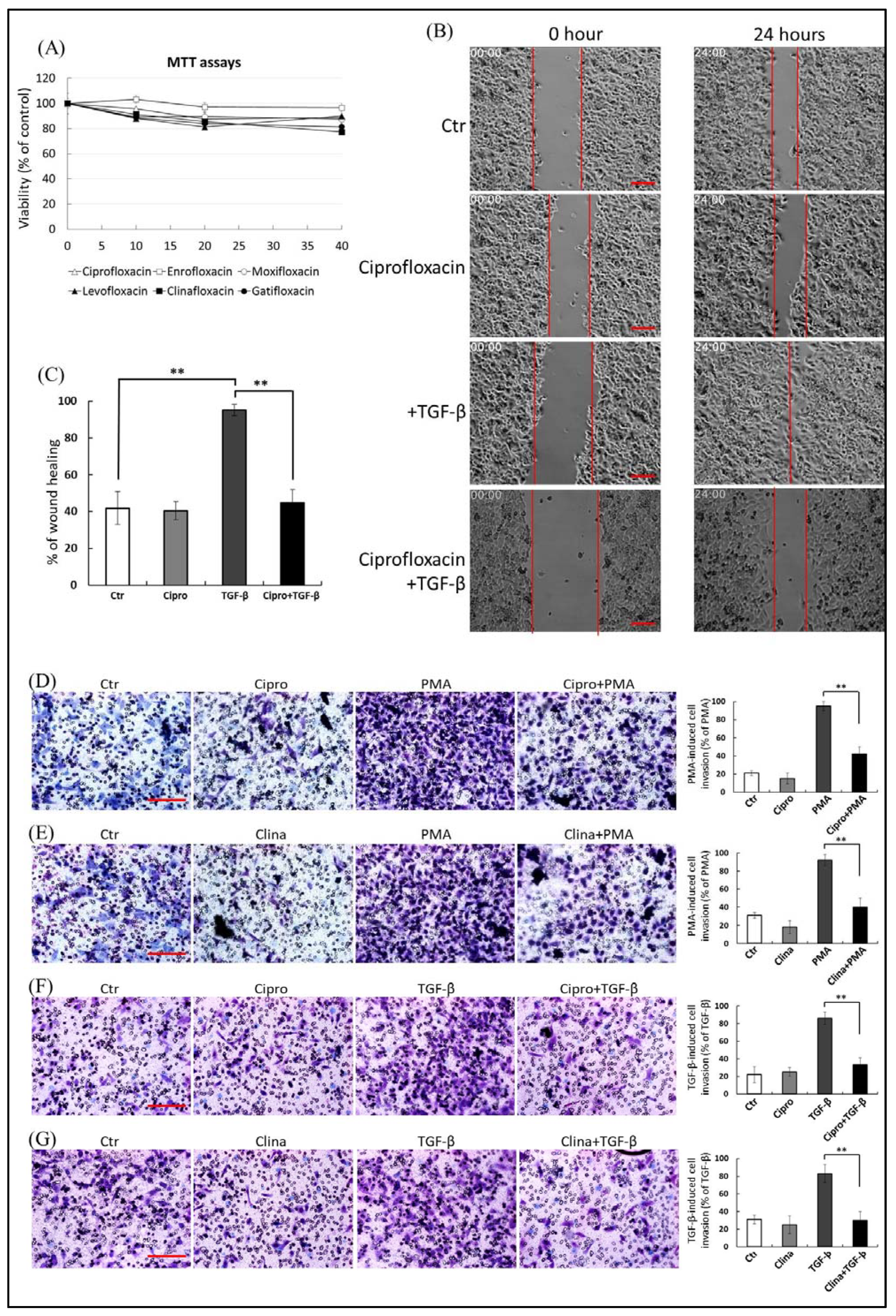
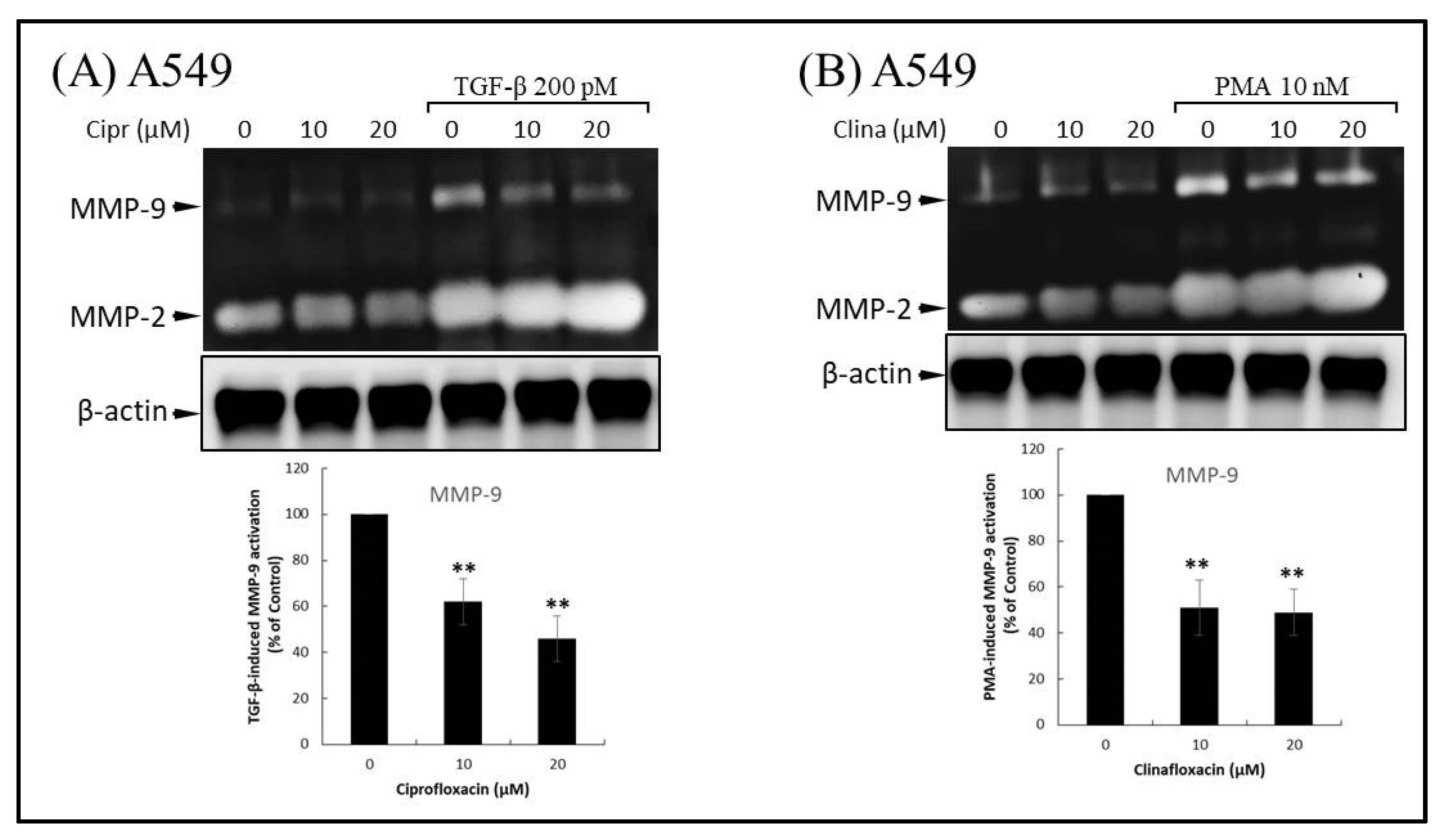

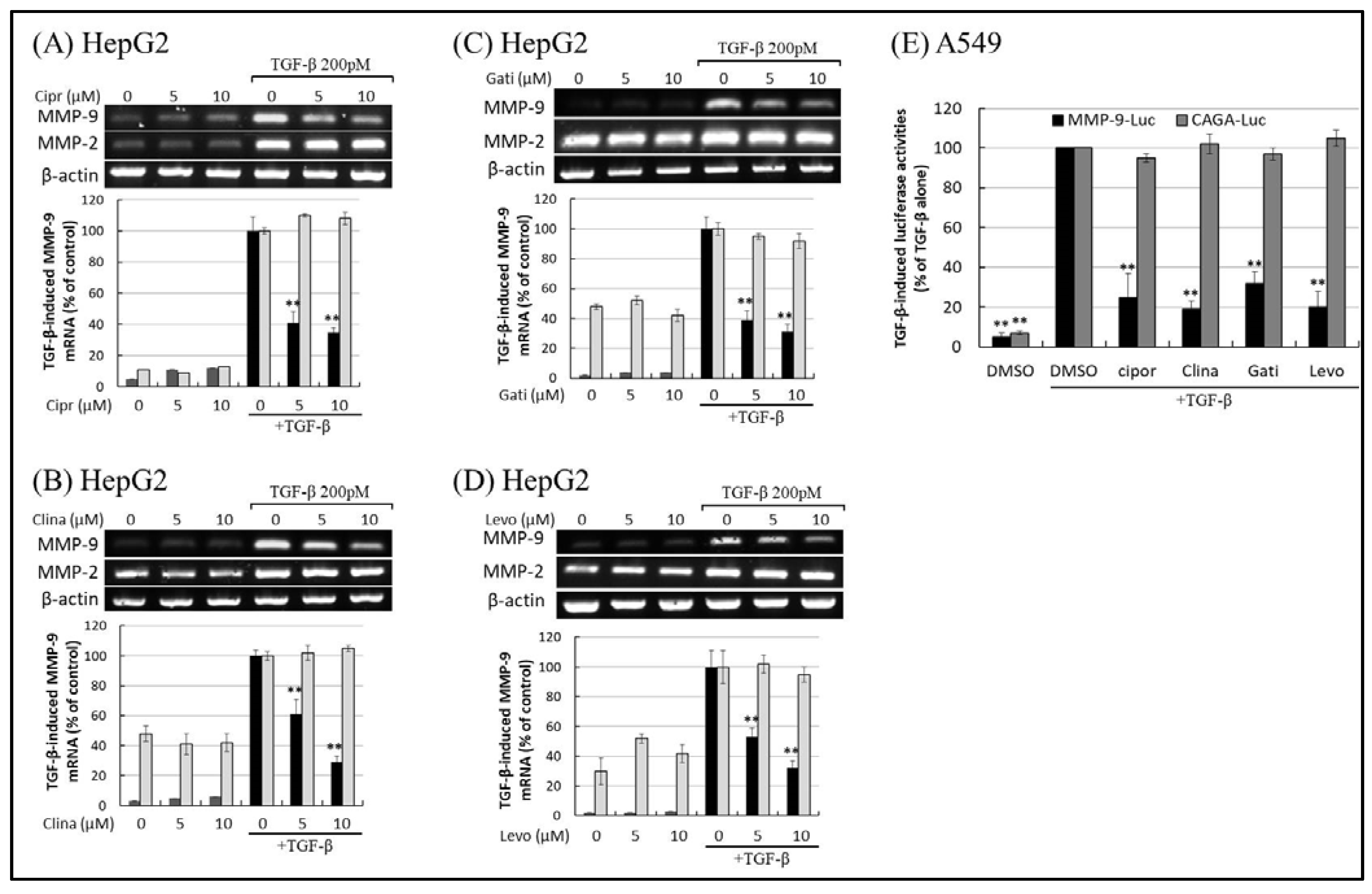
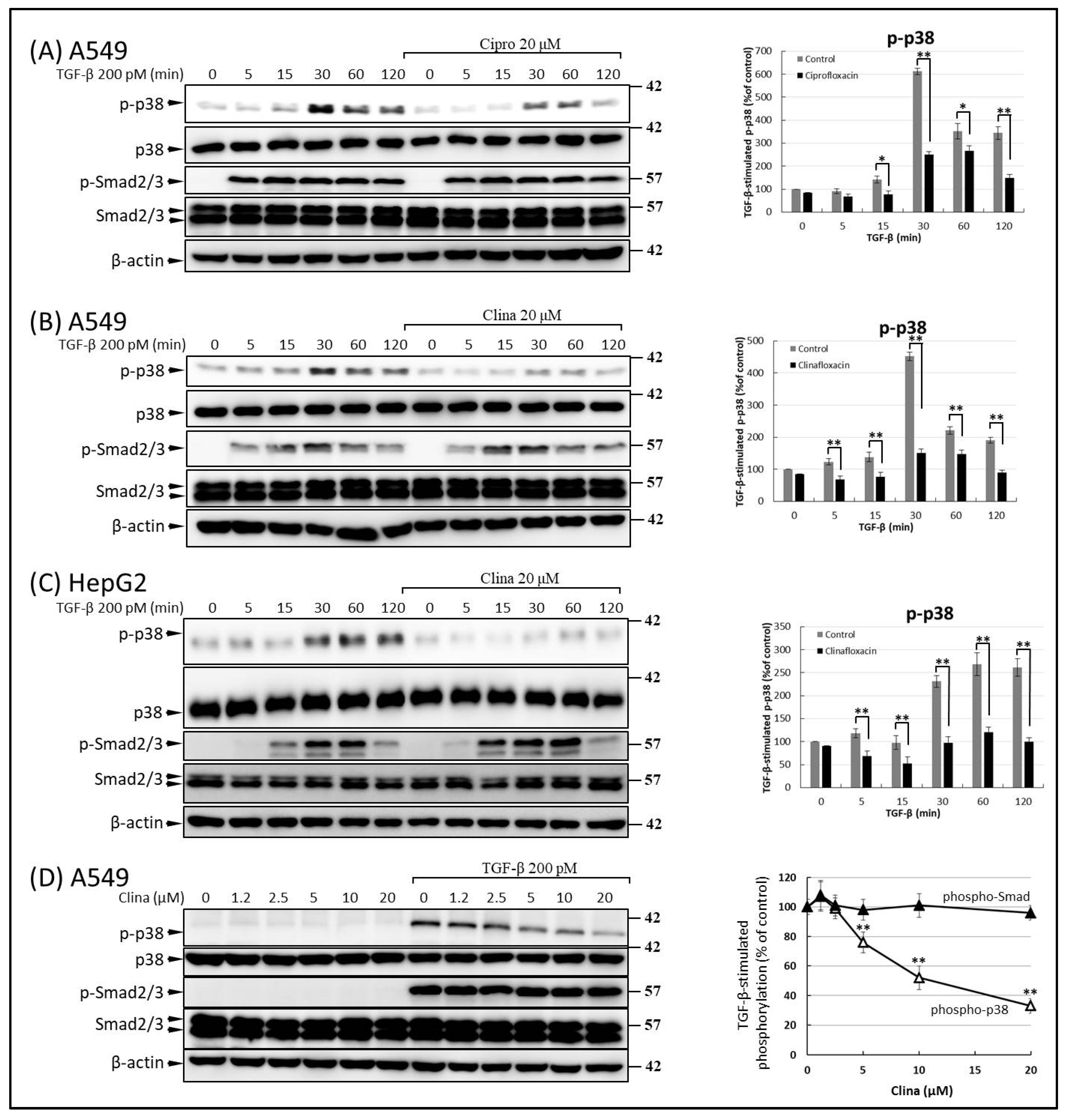
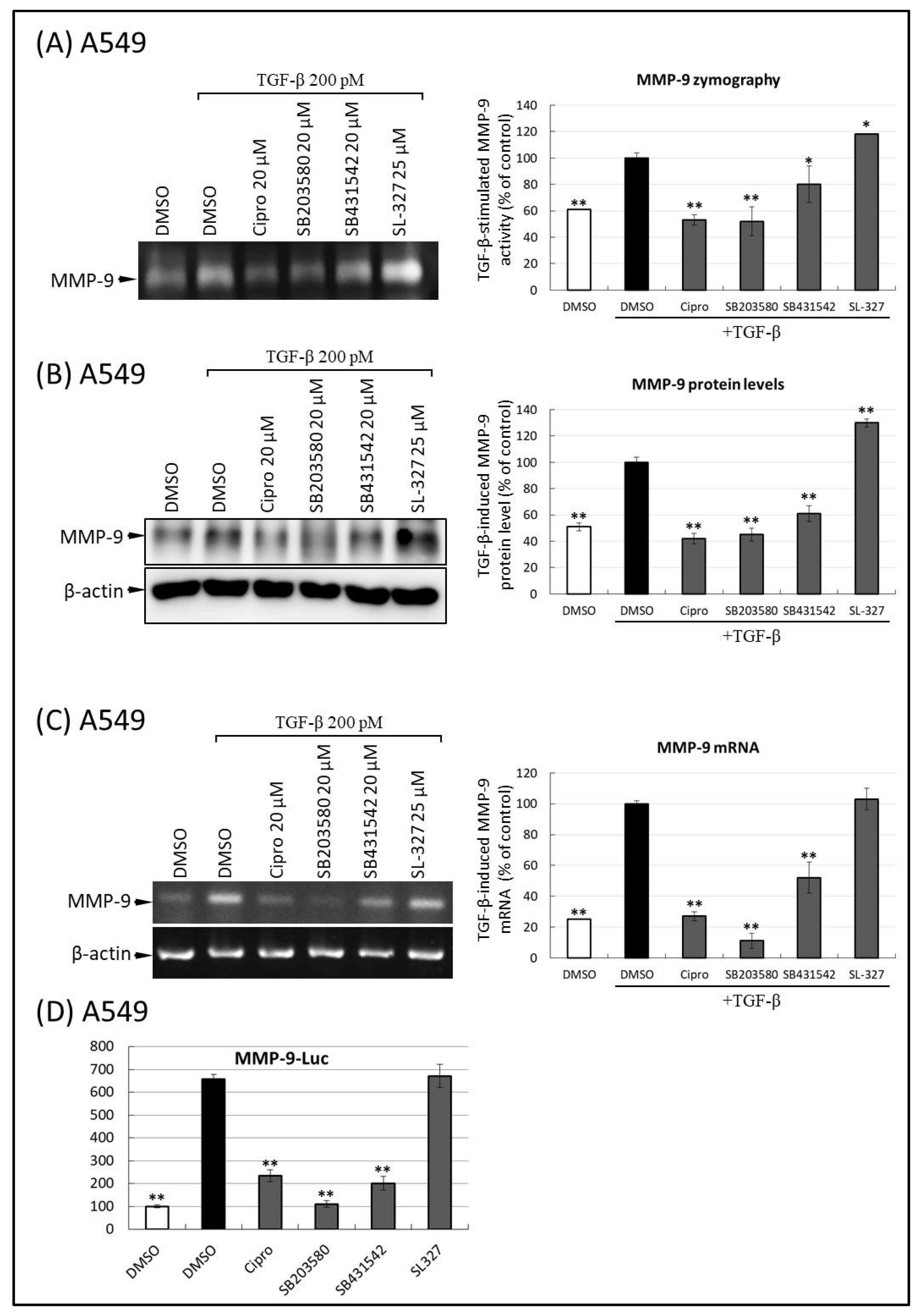
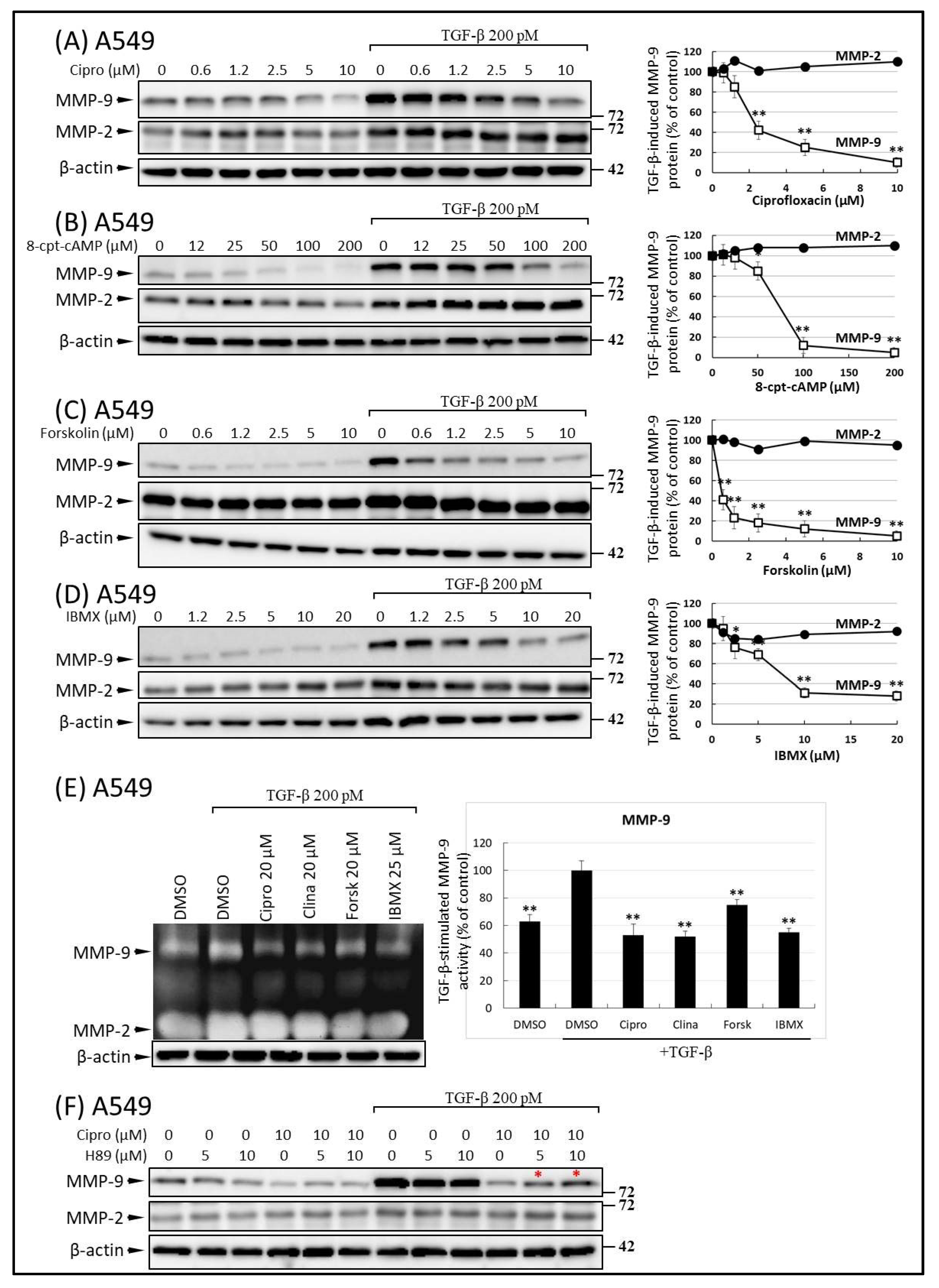
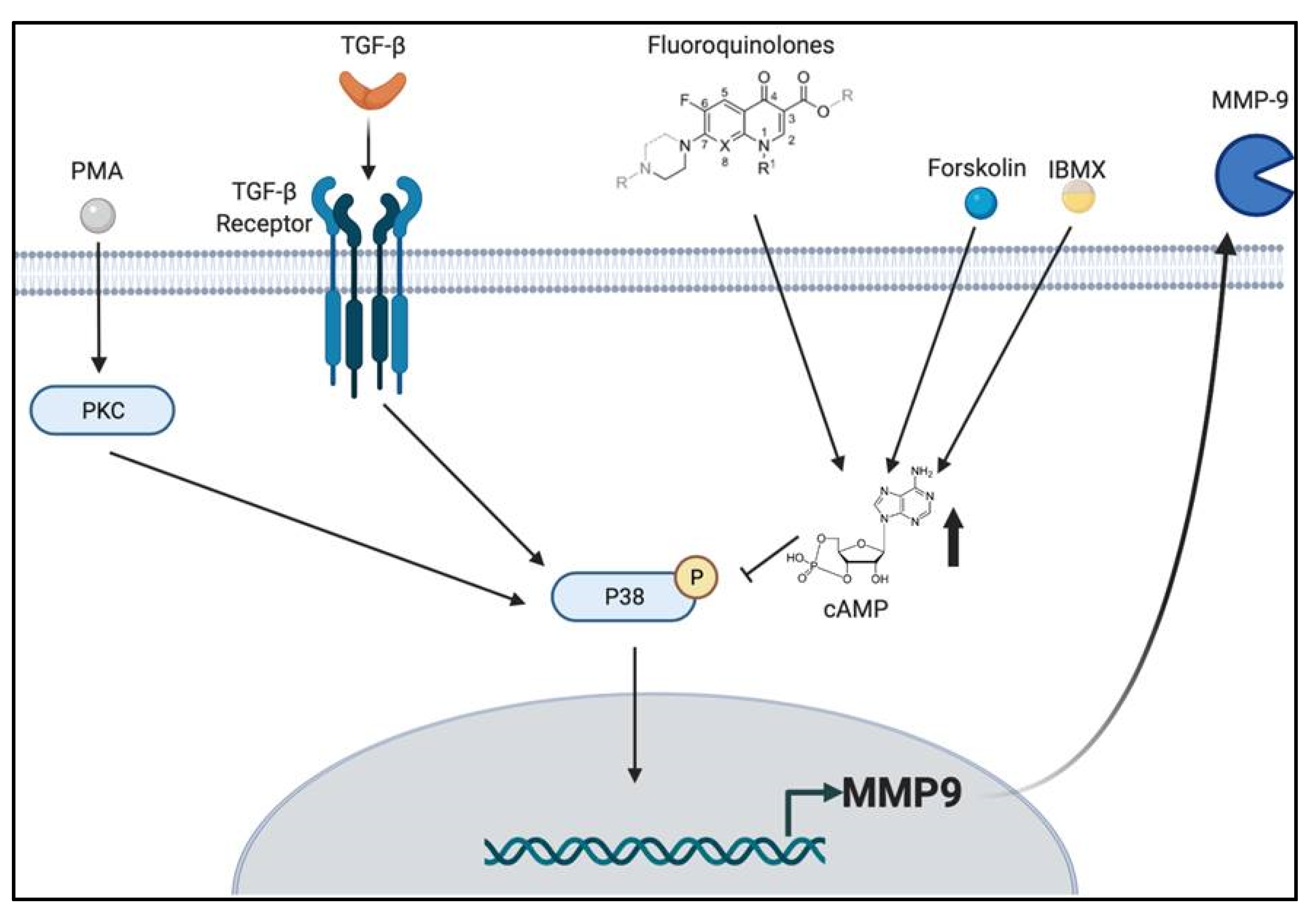
| Gene Name | Primer Sequences |
|---|---|
| MMP-9 | Forward 5′-CGT GCT GAC ATC TAT GCA AT-3′ Reverse 5′-AGC TGC TCC ATT GGC ATA C-3′ |
| MMP-2 | Forward 5′-TGC ACA TCG TCC TGT GGA C-3′ Reverse 5′-GTC TCA AAC TGC TCT GAA GTG TTC-3′ |
| PAI-1 | Forward 5′-GGC TGA CTT CAC GAG TCT TTC A-3′ Reverse 5′-TTC ACT TTC TGC AGC GCC T-3′ |
| Vimentin | Forward 5′-GAC GCC ATC AAC ACC GAG TT-3′ Reverse 5′-CTT TGT CGT TGG TTA GCT GGT-3′ |
| β-actin | Forward 5′-CTA CAA TGA GCT GCG TGT GG-3′ Reverse 5′-AAG GAA GGC TGG AAG AGT GC-3′ |
Publisher’s Note: MDPI stays neutral with regard to jurisdictional claims in published maps and institutional affiliations. |
© 2021 by the authors. Licensee MDPI, Basel, Switzerland. This article is an open access article distributed under the terms and conditions of the Creative Commons Attribution (CC BY) license (https://creativecommons.org/licenses/by/4.0/).
Share and Cite
Huang, C.-Y.; Yang, J.-L.; Chen, J.-J.; Tai, S.-B.; Yeh, Y.-H.; Liu, P.-F.; Lin, M.-W.; Chung, C.-L.; Chen, C.-L. Fluoroquinolones Suppress TGF-β and PMA-Induced MMP-9 Production in Cancer Cells: Implications in Repurposing Quinolone Antibiotics for Cancer Treatment. Int. J. Mol. Sci. 2021, 22, 11602. https://doi.org/10.3390/ijms222111602
Huang C-Y, Yang J-L, Chen J-J, Tai S-B, Yeh Y-H, Liu P-F, Lin M-W, Chung C-L, Chen C-L. Fluoroquinolones Suppress TGF-β and PMA-Induced MMP-9 Production in Cancer Cells: Implications in Repurposing Quinolone Antibiotics for Cancer Treatment. International Journal of Molecular Sciences. 2021; 22(21):11602. https://doi.org/10.3390/ijms222111602
Chicago/Turabian StyleHuang, Cheng-Yi, Jenq-Lin Yang, Jih-Jung Chen, Shun-Ban Tai, Yu-Hsuan Yeh, Pei-Feng Liu, Ming-Wei Lin, Chih-Ling Chung, and Chun-Lin Chen. 2021. "Fluoroquinolones Suppress TGF-β and PMA-Induced MMP-9 Production in Cancer Cells: Implications in Repurposing Quinolone Antibiotics for Cancer Treatment" International Journal of Molecular Sciences 22, no. 21: 11602. https://doi.org/10.3390/ijms222111602







